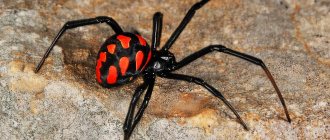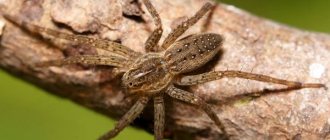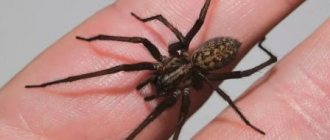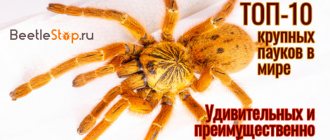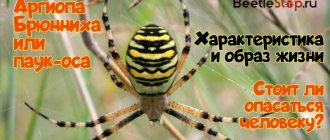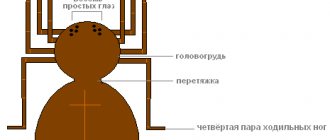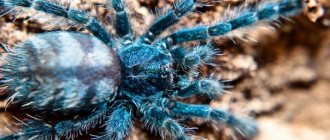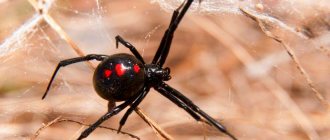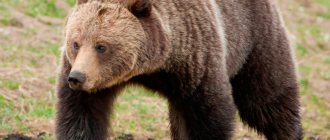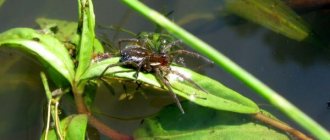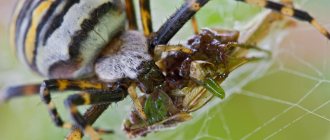Appearance
The huntsman spider, or, as it is also called, the crab spider, is one of the largest representatives of its order. This insect got its name “Jager” due to its predatory lifestyle. This species was discovered quite recently - in 2001 in the Khammouan province in central Laos.
The leg span of females reaches 30 cm, males are half that size . The insect is distinguished by thin, elongated limbs, which are crowned at the ends with claws, like those of a crab. With these claws, like pincers, the predator grabs its prey.
The crab spider has an elongated, oval body, 3 to 5 cm long. It is connected to the cephalothorax by a thin bridge. There are 4 pairs of eyes on the head, which, although they provide a good all-round view, are not sharp.
Representatives of this species do not have excellent eyesight; they rely more on their sense of smell and touch during the hunting process. Predators react to movement, see shadows and silhouettes.
. The limbs are pubescent and have unevenly spaced dark spots.
The special structure of the curved legs allows the crab spider to move not only forward, but also sideways. The head of the predator is crowned with a pair of powerful jaws that can cope with small rodents and birds.
Description:
The body size of the jumper is very small and often does not exceed two centimeters.
All representatives of the jumping family have 8 eyes, which are arranged in three rows. In the first row there are 4 large eyes that occupy the front part of the head. The front or main ones are very large and mobile. The second row of eyes consists of two very small eyes that are located in the middle part of the head. The third row consists of 2 very large eyes located at the corners of the back of the head. The main eyes of jumpers are long-focal, and they produce a large image on the retina in a small field of view (just like in a camera with a telephoto lens). The visual elements of the retina of the horse's eye are located quite close to each other, which is why the jumping spider is able to examine its prey in detail, but at a short distance, due to the small field of view. However, he has very mobile eyes and the small field of view is not a hindrance at all. In addition to all this, the main eyes of the racehorse can distinguish colors. The large lateral eyes, which are located in the third row, are not able to distinguish the shape of objects, but they are located in such a way that they can easily notice movement from behind and from the side. Small eyes from the second row are able to distinguish objects and even determine the distance to them.
Jumping spider photo The coloring of spiders is varied, and is similar to the coloring of ants, beetles and even false scorpions. They also have the ability to change the blood pressure in their hind legs, causing them to suddenly straighten, allowing them to jump distances of up to 60 centimeters.
Nutrition
Thanks to its impressive size, the predator can diversify its diet not only with small insects, but also with quite large animals.
The basis of nutrition is:
- mice, as well as other rodents.
- Small lizards, frogs.
- Comparable in size.
- Insects (cockroaches, beetles, flies).
When attacking a prey, a predator immediately injects poison into its body. The substances it contains instantly paralyze the insect or frog, preventing resistance.
. Their task is to soften the insides, preparing the prey for eating.
Since crab spiders became known to the world, many cases of attacks by these creatures on small reptiles and rodents have been recorded.
Thus, in the Australian city of Coppabella, a large representative of this species caught a mouse. The size of the animal’s body was comparable to the body of the spider itself, which did not stop it from lifting its prey up the vertical wall of the refrigerator.
An interesting incident happened in the Australian city of Queensland. A couple preparing for Sunday dinner discovered a crab spider hanging from the living room window. The insect was one of the largest representatives of its genus and was the size of a dinner plate. The owners of the house managed to record how he successfully attacked and ate a long gecko, the size of a spider itself.
Behavior
The striped hunter leads a semi-aquatic lifestyle. It spends most of its time on coastal plants, dangling its front legs into the water and looking out for potential prey.
In case of danger, he can dive and survive without air for up to 30-60 minutes.
Hunting is carried out mainly from ambush. Only occasionally can a spider running along the water surface, after one unsuccessful attempt, immediately run after another potential prey that accidentally turns up. Having overtaken the victim, it paralyzes it with its poison.
Reproduction:
Using his unusual vision, the male jumping spider finds a female, after which he begins to perform his unusual mating dance for this female. The spider raises its front legs and begins to swing them, also bending its abdomen and spinning in place. Then, waddling from side to side, it dances next to the female in small semicircles that gradually narrow. After the male approaches the female completely, the dancing male begins to spin quickly, trying to lure the female into this round dance. Males during the mating season, and not only, show very strong aggression towards each other. That is why, if you put a mirror in front of a horse, it begins to react so funny and even rushes at the reflection.
Behavior, lifestyle
All hunters live near bodies of water; they are often caught together with duckweed with a net or seine. They live on the water or in close proximity. They do not weave trapping nets to catch prey; they hunt actively. Once on the water, they quickly form a raft from available materials - dry grass, leaves, bark. They entangle several parts with a web, sit on a raft, calmly swim through a swamp, a deep puddle.
Striped spider hunter
The main diet is insects. And also fry, crustaceans, snails, caterpillars. Large specimens prey on fish, frogs, newts, snakes, and snakes. They attack from a secluded place. They inject poison and saliva. The first substance paralyzes the victim, the second liquefies the insides into a broth. After a few minutes, the predator starts eating.
They gather in pairs only during the mating season. After fertilization, a hungry female can safely eat her “suitor.” To lay eggs, it forms a cocoon of spider webs. It can hold from 500 to 1000 pieces at a time. The female attaches them to plants near the pond or carries them on herself. The incubation period is 3 weeks. Young spiders almost immediately begin to live independently.
Danger to humans
Hunters are nocturnal and can crawl into a person’s house in search of food. They hide under furniture, in shoes, among clothes, in cabinets with dishes.
On a note!
Swelling, swelling, and redness occur at the site of the spider bite. People with weak immune systems, allergy sufferers, and young children often experience a deterioration in their health - weakness, dizziness, headache, nausea, diarrhea, vomiting. The condition returns to normal in a few days. To speed up the effect, take antihistamines. The hunter is not one of the deadly poisonous spiders.
External signs of a redback spider
The redback spider differs from related species by the presence of a red stripe on the upper side of the cephalothorax. The female is 10 mm long, her body is the size of a large pea, and is significantly larger than that of the male (on average by 3-4 mm). The female is black with a red stripe, which is sometimes interrupted on the dorsal surface of the upper abdomen.
Red, hourglass-shaped spots are visible on the ventral side. The young female has additional white markings on her abdomen, which disappear as the spider matures. The male is usually light brown in color with a red stripe on the back and light spots on the ventral side of the abdomen, which are less pronounced than those of the female. The male retains white markings on the upper side of the abdomen until adulthood. The redback spider has slender legs and venom glands.
Redback Spider Reproduction
Redback spiders can mate at any time of the year, but are most likely to mate during the summer months when temperatures are warmer. Several males appear on the web of a large female. They compete with each other, often fatally, to mate, with the courtship period lasting about 3 hours. However, the leading male may rush when other males appear.
If a persistent spider approaches the female too quickly, she eats the male even before mating.
During copulation, sperm enters the female's genitals and is stored until the eggs are fertilized, sometimes up to 2 years. After mating, the spider does not react to other applicants and 80% of males cannot find a mate. The female produces several egg packets, which have about 10 egg sacs, each containing approximately 250 eggs. White eggs are placed on the web, but after a while they turn brown.
The duration of development depends on the temperature; the optimal temperature is 30°C. The spiderlings appear on the 27th - 28th day, they quickly leave the mother’s territory, on the 14th day they scatter on the web in different directions. Young females are able to reproduce after 120 days, males after 90 days. Females live 2-3 years, while males only live about 6-7 months.
A wonderful creation of nature - the web
Web
A person doesn’t even imagine how fabulous this invention of nature is when, stumbling upon a cobweb in the park, he irritably brushes it off his face. If the length of an ordinary web were equal to the length of the equator, it would have a mass of only about 0.4 kg. It turns out that the simplest spider has the strongest and most elastic material found on planet Earth. By secreting an adhesive component to lubricate the web threads, the spider can weave them of varying lengths and thicknesses.
With the help of thin threads of web stretched in different directions from its shelter, the spider, which has naturally poor eyesight, is able to communicate with the environment. The web is his material for construction. Also, with its help, the spider extends its genus and habitat - the flying web takes its offspring with it far from the place of birth.
Theraphose blonde
It is known to many as the goliath tarantula. It is rightfully considered the largest spider, since the length of its body can reach 9 cm, and with outstretched legs - 28 cm. Its color is brown or reddish with a red tint.
Goliath tarantulas live on the South American continent. They dig holes for themselves in the ground under trees or occupy the shelters of their defeated enemies. They feed mainly on small animals: lizards, rodents, chicks and others. The goliath's bite is painful, but is only dangerous for allergy sufferers. Despite its nervousness and aggressiveness, this spider is a fairly popular pet. And yet, starting it is not recommended for novice arachnophiles.

